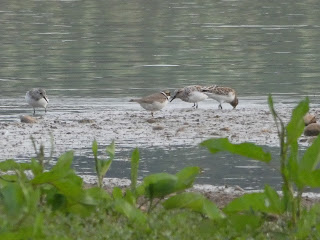Heavily cropped Moltoni's Warbler
Operation Moltoni's
Spot the Moltoni's
Oystercatcher waiting on the sign for us
View of the reserve
Sandwich Tern colony
Relaxed seals on the point
Spotted Flycatcher
Meadow Pipit
Blakeney Harbour
Great to see the legendary Cliff Smith
Snapped in action
All aboard
What happens when you get a Rosefinch in your garden
Marsh Harrier causing bedlam above the gull colony
Avocet
Mediterranean Gull
Fantastic selection of Godwits in different plumages
With continued favourable winds an east coast mega beckoned. After doing the patch and a spot of coffee & cake news emerged on a possible Moltoni's Warbler in Norfolk.
With access via a 2.75 mile shingle walk and the chances of the birds departure over night we didn't fancy our chances. But our hopes were raised when we noticed thick fog on the Norfolk coast which starting us to hatch a plan together.
Leaving Redditch at 6.10am we were an hour into our journey when news broke that the bird was still present, quickly followed news that access to Blakeney Point by boat could be possible. Roland floored it for next two hours, we even reached 60 mph once. Where to park in the huge car park wasted more valuable minutes but it's great to go through the routine.
Quickly down to the quayside the potential boat was full until another stroke of luck happened when the Temple boats received two cancellations for the Seal trip. As long as we were happy to see the seals they would drop us on the point. Deal ! £12 but money well spent.
We were off chugging through the stunning harbour with Sandwich Terns over head. At the end of the point there were good numbers of Sandwich Tern, a nice number of Little Tern & Common Tern, a single Arctic Tern, Ringed Plovers & of not forgetting the Common & Grey Seals.
Once landed on the point we were quickly marching towards a group of 30 or so birders who then suddenly split up…….happy they had seen it well, quite the opposite the bird had taken off and disappeared in the minutes it took us to walk over. After five minutes of head scratching we started scouring likely hotspots. Then suddenly we saw three birder running quickly towards the lifeboat sheds ! The Moltoni's was back and showing nicely flitting over the sheds and working it's way towards the assembled crowd of around 60 birders. There was some relieved faces including our own. To read the finders report click here.
In all honesty it looks like a Subalpine Warbler, there is fantastic paper published online which makes an interesting read. Hats off to those who identified this bird, it certainly made a lot of birders happy who didn't travel to Scotland to see the same species there.
After getting our target bird sorted we retreated away from the crowd to sit by the famous plantation to eat our lunches. It looked bird less then suddenly a Spotted Flycatcher flew in giving us and the legend that is Cliff Smith, some excellent views.
Roland then produced a master stroke of negotiating us back to the quay on a different boat. I still don't know how he pulled this off but the time saved would open up the rest of the day for us to enjoy the coast.
We headed up to Salthouse where a Rosefinch was calling constantly but just not showing. Given we had seen the species before we headed into Cley visitor centre for a spot of afternoon tea and cake, just had to be done.
Our final destination would be Titchwell where we added Red-crested Pochard, Marsh Harrier, Little Gull, Avocet, Bar & Black-tailed Godwits, Mediterranean Gulls and a Bearded Tit to the day list.
We were not kidding ourselves that everything had dropped perfectly into place for us, well worth remembering when we are not so lucky in future. A top day's birding and faith restored in Norfork (slightly).


























































